Abstract
The petrology, mineralogy, elemental geochemistry, biology and PGEs characteristics of the black shale of the Wufeng and Longmaxi Formations in the CN outcrop of the Sichuan Basin are studied in this paper. The distribution and change in PGEs at different horizons are summarized, and the reasons for PGEs enrichment are discussed. The results show that the PGEs in the organic-rich shale segment are obviously enriched, which is positively correlated with the Total Organic Carbon (TOC) content and has a Pt–Pd distribution characteristic. δEuN, Pd/Pt, (Pt + Pd)/(Os + Ru + Ir), etc., and SiO2–Al2O3 and It/Pt–Pd/Pt discrimination diagrams, indicate that they are not extraterrestrial sources, nor are they the origins of normal seawater deposition but they are related to hydrothermal deposition. The enrichment process of PGEs is relatively complicated and is controlled by the impact of the sedimentary environment in the restricted basin. The anoxic water environment and organic-rich environment are the main factors of PGEs enrichment. PGEs and TOC have a good positive correlation and can be used as index parameters for sedimentary environments and organic matter enrichment.
1. Introduction
Platinum group elements (PGEs) include six elements: ruthenium (Ru), rhodium (Rh), palladium (Pd), osmium (Os), iridium (Ir) and platinum (Pt). PGEs are high-temperature elements with strong sulfur and iron affinity. It is understood that black shale migrates and becomes enriched in hydrothermal solutions at 300 °C; however, its chemical activity below 200 °C and its low-temperature geochemical properties are still not clear. In traditional geochemical theory, PGEs enrichment is mainly related to basic ultrabasic rocks [1,2], but in recent years, research in various countries in Europe, Asia, North and South America, and especially in large areas of southern China, have found PGEs enrichment in black shale [3,4,5,6,7]. These shales have no direct space–time relationship with basic ultrabasic rocks. Therefore, the study of PGEs in black shale will be of great significance to understanding its low-temperature geochemical properties [8].
The source of PGEs in the black rock series is currently an area of high research interest. Predecessors have performed much research on the source of PGEs in the black rock series, which is widely developed due to the paleo-oceanic anoxic event at the Precambrian–Cambrian boundary [4,9,10]. However, there are still many controversies regarding the origin and enrichment of PGEs in the black rock series. These viewpoints mainly focus on the origin of extraterrestrial matter, the origin of normal seawater and the origin of hydrothermal solution. With the vigorous development of unconventional oil in China, major breakthroughs have been made in shale gas from the Lower Paleozoic Longmaxi Formation (Fm for short) in the Sichuan Basin. Similar to the Cambrian system black shale, the black shale of the Wufeng Fm and Longmaxi Fm in the Ordovician–Silurian (O–S for short) transition period, also rich in organic matter and deposited in anoxic seawater, is an important source rock and reservoir in South China. A large number of research achievements have been made in shale sedimentary environments, burial history and hydrocarbon generation potential [11,12,13,14]. However, systematic PGEs geochemical studies of this sequence are rarely reported. In this paper, the PGEs of organic-rich black shale in the Wufeng Fm and Longmaxi Fm will be systematically analyzed. Combined with the characteristics of major and trace rare earth elements, rock minerals and paleontology, the characteristics and modes of PGEs enrichment will be recognized, and the genesis of the PGEs anomaly and its indication of the sedimentary environment will be preliminarily discussed.
2. Geological Setting
The Sichuan Basin has experienced multistage tectonic movements, forming a basin structure pattern surrounded by mountains. Oil and gas accumulation has been found in much of the strata in this area [15,16]. Shale gas reservoirs are mainly found in the Cambrian Niutitang Fm, the Late Ordovician Wufeng Fm and the Early Silurian Longmaxi Fm. Under the influence of the Caledonian movement, large-scale tectonic uplift occurred at the end of the Silurian Period, and the palaeogeographical pattern of “three uplifts and one depression” was formed in the Sichuan Basin [12]. At the same time, influenced by global ice cap formation and melting events at the transition of the Ordovician to the Silurian, the global climate and sea level dramatically changed [12,17] during the middle and late stages of Wufeng Fm deposition (i.e., the early and middle stages of Hernante), the biological shell limestone of the Guanyinqiao Member (Mem for short) of the Wufeng Fm was deposited due to the mass extinction of graptolite and Hirnantia Fauna [18,19]. In the early stage of Longmaxi Fm (the late Hernante early stage of Longmaxi Fm), climate warming, glacier melting and biological recovery formed organic rich black shale of Longmaxi Fm [18,20].
The preliminary geological survey found that the PGEs content at the bottom of the Guanyinqiao Mem and Longmaxi Fm at the Late Ordovician Early Silurian (O-S) transition interface in the Sichuan Basin has a sudden increase (PGEs > 10 × 10–9), a bimodal element combination (Figure 1) enriched with a large amount of acidic elements (Mo, Pb, Zn, B, W and REEs) and basic volcanic rock elements (Fe, Ni, V, Cu and PGEs) occurring at the same time, which represents a major geological event that has been responded to in the whole Sichuan Basin. It may also be the “biological explosion and extinction” event at the end of the glacial period, or it may have been affected by the submarine hydrothermal event. According to the well diagram of PGEs of Well XD2–CN outcrop–Well HD1 in southwest-northeast direction of the Sichuan Basin, the abrupt enrichment of PGEs occurs at the bottom of Longmaxi Fm at the location of the Ordovician Silurian transition interface, which is significantly related to the TOC peak (>4%). It is speculated that the enrichment of PGEs may not only be affected by thermal fluid but also be related to the biological mass extinction caused by climate disasters and the basin limitation caused by structure. In this paper, the CN outcrop is selected as the research object, and the black shale of the Wufeng Fm and Longmaxi Fm is systematically studied to disclose the characteristics and causes of PGEs enrichment in detail to understand the indicative significance of PGEs enrichment to the environment.
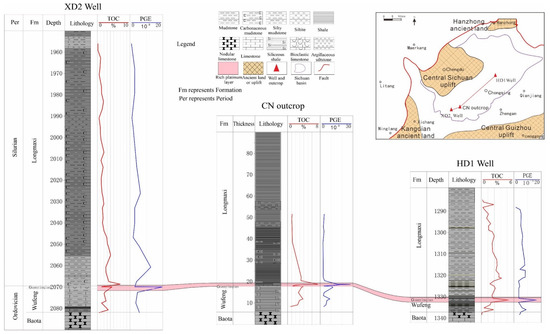
Figure 1.
Well Connection Diagram of the Wufeng Fm and Longmaxi Fm in Sichuan Basin.
The CN outcrop is located on the southern margin of the Sichuan Basin (Figure 2a). The main lithologies are carbonaceous siliceous shale and calcareous mudstone. The outcrop from bottom to top can be divided into six sections (Figure 2b). Section A is located at the bottom of Wufeng Fm, with a thickness of about 2 m and the lithology is mainly gray calcareous silty mudstone; Section B is in the middle of Wufeng Fm, with a thickness of about 6 m and mainly gray-black calcareous siliceous mudstone; Section C is in the upper part of Wufeng Fm, with a thickness of about 3~4 m and the lithology is mainly black calcareous mudstone and graptolite development (Figure 2b). At the top of the Section C of Wufeng Fm is biolimestone mudstone of Guanyinqiao Mem with a thickness of approximately 0.8 m (Figure 2b and Figure 3a); Section D is at the bottom of Longmaxi Fm with a thickness of approximately 1.5 m and mainly the black siliceous carbonaceous shale; Section E is in the lower part of the Longmaxi Fm, and has a thickness of approximately 20 m and mainly black calcareous shale, with graptolite development; Section F is located in the middle-upper part of Longmaxi Fm, with a total thickness of about 280 m and the lithology is mainly gray silty mudstone and argillaceous siltstone, with few graptolites. The lithology and biological characteristics of the Guanyinqiao Mem in the Ordovician–Silurian (O–S) transition horizon can be divided into three small layers from bottom to top (Figure 3a,d,e): the lower part is gray-black calcareous siliceous shale with a thickness of approximately 0.2 m, and brachiopod fossils and graptolite fossils are occasionally seen, which gradually transited with the underlying calcareous siliceous shale of the Wufeng Fm; the middle part is dark gray calcareous shale with a thickness of approximately 0.4 m, and a large number of brachiopod fossils are found; and the upper part is approximately 0.2 m thick black graptolite shale, with a large amount of graptolite, similar to the bottom of the overlying Longmaxi Fm [21]. From the perspective of lithological and palaeontological characteristics, the Guanyinqiao Mem is in conformable contact with the graptolite shale section of the overlying Longmaxi Fm and the underlying Wufeng Fm, which reveals that the ancient water depth experienced a cycle change from deep to shallow back to deep during the early and middle Wufeng Fm––the Guanyinqiao Mem–early Longmaxi Fm. Among them, the PGEs-rich layer is mainly located in the upper part of the Wufeng Fm––Guanyinqiao Mem––and the lower part of the Longmaxi Fm. In particular, Section D (Figure 2b) at the bottom of the Longmaxi Fm is approximately 1 m thick. The PGEs, Au, Ag, Cu, Zn, Mo, Ni and other metals in this layer are strongly enriched. The lithology is carbonaceous siliceous shale, with a large number of organisms, and the TOC value is up to 7%.
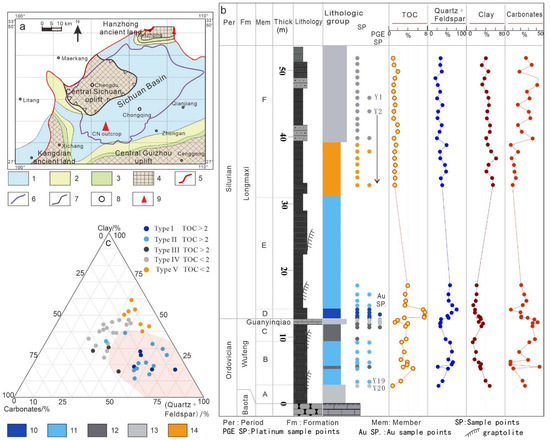
Figure 2.
(a) The sedimentary facies map of the Wufeng Fm and Longmaxi Fm and outcrop location in the Upper Yangtze Craton. (b) Stratigraphic column of the Wufeng Fm and Longmaxi Fm and the sampling location; (c) Ternary diagram of mineral composition of Wufeng and Longmaxi black shale. 1. Deep water shelf facies; 2. Shallow water shelf facies; 3. Tidal-flat facies; 4. Ancient land or uplift; 5. Fault; 6. Basin boundary line; 7. Sedimentary facies boundary; 8. Place name; 9. Sampling location; 10. Type I: Siliceous carbonaceous shale, TOC > 2%; 11. Type II: Calcareous siliceous shale, TOC > 2%; 12. Type Ⅲ: Calcareous carbonaceous mudstone TOC > 2%; 13. Type IV: bioclastic calcareous mudstone and calcareous silty mudstone, TOC < 2%; 14. Calcareous silty mudstone and argillaceous siltstone, TOC < 2%.
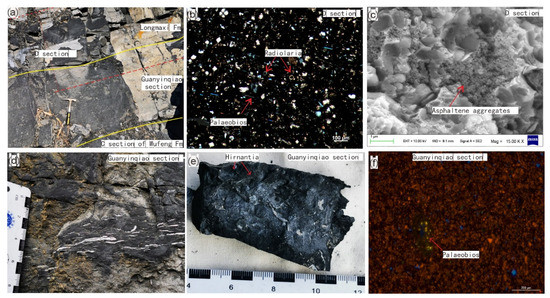
Figure 3.
Mineral, rock and biological characteristics of the the Wufeng Fm and Longmaxi Fm. (a) outcrop characteristics, photo; (b) mineral and biological characteristics of Section D of Longmaxi Fm, thin section photo; (c) quartz and organic matter in Section D of Longmaxi Fm, SEM; (d) bioclastic limestone of Guanyinqiao Fm, photo; (e) Hirnantia of Guanyinqiao Mem, photo; (f) biological features of Guanyinqiao Mem of Wufeng Fm, Cathodoluminescence photo.
3. Samples and Methods
The studied outcrop in this paper is located in Changning County, Yibin City, Sichuan Province. A total of 43 outcrop samples of the Upper Ordovician Wufeng Fm–Lower Silurian Longmaxi Fm were collected. The detailed sampling location and sedimentary succession of the rocks are presented in Figure 2b. A total of 43 black mudstone samples were collected from the bottom to the top for TOC, mineral composition and major and trace element analyses. Among them, 20 elements were analyzed for PGEs and Ag and five samples were analyzed for Au. The collected samples contain many pyrite grains. The microscopic characteristics show that the main mineral compositions are quartz, pyrite, clay minerals, calcite and microorganism fragments.
To minimize the pollution and ensure the accuracy of the analysis, fresh and nonaltered rock samples should be collected as much as possible. Major elements were detected using an Axios Max pw4400/40 X-ray fluorescence spectrometer (PANalytical B.V., Almelo, Netherlands), with an analysis error of less than 1%. Trace elements were determined by an X-Series II inductively coupled plasma mass spectrometer (Thermo Fisher Scientific, Waltham, MA, USA) with an analytical accuracy of better than 5%. Au was performed by solubilization of aqua regia and then determination by the AAS (Atomic Absorption Spectrometry) method. Mineral composition analysis was quantified using a Brooker D8 Advans X-ray diffractometer and JEOL JSM-6610LV SEM with Gatan 697 argon ion-polishing instrument. TOC was measured using the multi n/C 3100 total carbon analyzer in Jena, Germany. The above tests were completed in the Key Laboratory of Shale Gas, Chongqing Institute of Geological Survey, Chongqing, China.
The contents of PGEs were determined by nickel matte assay with ICP-MS (PerkinElmer NexIon PE300D) and determination accuracy RSD ≤ 6.5. Ag was dissolved by aqua regia bath and the analysis accuracy was better than 15% [19]. The above tests were completed at the National Geological Laboratory, Beijing, China.
The determination of sulfur isotopes (34SV-CDT) was completed in the analysis and testing research center of the Beijing Institute of Nuclear Industry Geology, Beijing, China. Delta V plus gas isotope mass spectrometry was used for determination, and the analysis accuracy was better than ±0.2 ‰ [22].
4. Analytical Results
4.1. Total Organic Carbon and Mineralogical Characteristics
The TOC content and mineral composition characteristics of 43 samples collected from the CN outcrop are shown in Figure 2b, and the mineral composition corresponding to PGEs samples is shown in Table 1. The TOC content in the CN outcrop is generally high, with a value of 0.74~7.47% and an average value of 2.59%. Among them, the middle and upper part of Wufeng Fm (Section B + C) and the lower part of Longmaxi Fm (Section D + E) are organic rich shale (TOC > 2%). The organic matter decreases in the middle-upper part of Longmaxi Fm with TOC < 2% (Section F). As shown in the X-ray diffraction (XRD) analysis results, the samples are mainly composed of quartz, clay minerals and carbonate minerals, with quartz contents of 26~74% and an average value of 42%; clay contents of 12~60% and an average value of 34%; carbonate mineral contents of 7%~44% and an average value of 24%; and an average pyrite content of 1.5%, which can be observed in most of the samples. According to the field stratigraphic observation and mineral composition analysis, combined with TOC and biological characteristics, the black shale in the CN outcrop is divided into five lithologies (Figure 2b,c): Type I: Black thin-layer carbonaceous siliceous shale, TOC > 7%, quartz + feldspar > 50%, carbonate minerals < 25%, mainly located at the bottom of the Longmaxi Fm and the upper part of Guanyinqiao (Section D), with a thickness of approximately 1 m (Figure 3a). This section has a large number of organisms and is rich in PGEs and Au, Ag, Cu, Zn, Mo, Ni and other metal elements, which are PGEs enrichment layer; Type II: Black layered calcium-bearing siliceous shale, 2% < TOC < 5%, quartz + feldspar > 50%, carbonate mineral > 25%, mainly located in the middle of Wufeng Fm (Section B) and the bottom of Longmaxi Fm (Section E); Type III: gray-black calcareous carbonaceous mudstone, TOC > 2%, quartz + feldspar < 50%, carbonate mineral > 35%, mainly located in the upper part of Wufeng Fm and the lower part of Guanyinqiao Mem (Section C); Type IV: bioclastic calcareous mudstone and calcareous silty mudstone, TOC < 2%, quartz + feldspar < 50%, carbonate minerals > 25%, mainly including Guanyinqiao Mem (upper part of Section C) and upper part of Section F of Longmaxi Fm; Type V: calcareous silty mudstone and argillaceous siltstone, TOC < 2%, quartz + feldspar < 50%, clay > 40%, carbonate mineral < 15%, mainly located in the lower part of Section F of the Longmaxi Fm.

Table 1.
TOC, mineral composition, major element and sulfur isotope of CN outcrop.
Figure 2b shows that the TOC > 2% section is mainly concentrated at the bottom of the Wufeng Fm and Longmaxi Fm. The lithology is mainly black carbonaceous siliceous mudstone with a total thickness of approximately 30 m–40 m (Sections B, C, D and E). The quartz content is relatively high, and the clay mineral content is relatively low (Figure 2b). A large amount of strawberry-shaped pyrite, organic matter and radiolarian fossils can be seen under the microscope, which indicates that it was mainly deposited in the deep-water continental shelf facies reducing water body with high biological silicon content (Figure 3a–c). The TOC content of the Guanyinqiao Mem is approximately 1.7%, which is in gradual transition with the bottom of the Longmaxi Fm, and the brachiopod fossil Hirnantia biota is developed (Figure 3d,e). The TOC < 2% section starts from more than 30 m above the bottom of the Longmaxi Fm (Section F). The lithology is mainly calcareous silty mudstone. Compared with the lower section, the calcareous content and silty content of this section are significantly increased, and the siliceous content is decreased. Under the microscope, there are few siliceous organisms, such as radiolaria. It can be seen from the triangle diagram of mineral composition (Figure 2c) that the rocks with TOC > 2% are mainly close to the quartz end, indicating that a large amount of biogenic siliceous matter contributes to the high TOC [12,21].
4.2. Major and Trace Elements
The values of major elements in the black shale in CN outcrop are shown in Table 1. Compared with the UCC (Upper Continental Crust) values [23], CaO and MgO are slightly enriched and the other major elements are slightly depleted. The SiO2 content is relatively high, with values of 38.28% ~ 73.13%, and an average value of 52%, which is mainly biogenic silica [12,21,24], The Al2O3 values are 4.24%~14.83%, with an average value of 8.89%. The higher values of Al2O3 indicated more terrigenous material input in the Late Longmaxi Fm. The content of CaO is relatively high, ranging from 2.77% to 17.00%, with an average of 9.93%. The content of MgO is 1.19%-6.16% with an average value of 2.82%, mainly from carbonate minerals. The δ34S values varied from -10.5‰ to 15.7‰, and high values are observed in the C and D sections, which indicate that metal minerals in this segment clustered in the form of sulfide, and show the influence of more deep crustal hydrothermal deposition or biological reduction under an anoxic environment [7,25]
The abundance of trace elements of black shale samples from the CN outcrop is shown in Table 2 and Figure 4. Table 2 also contains the average content of trace elements of the UCC [26,27]. The enrichment factor (EF) is used to describe the enrichment of an element in black shale. The EF is defined as the ratio of the concentration of an element in black shale to its average concentration in the UCC [28]. The calculation results are as follows: XEF = (X/Al) sample /(X/Al)PAAS, where X and Al represent the contents of element X and Al in the sample, respectively. Samples were standardized using post-Archean Australian shales (PAAS). The dilution effect of carbonate on sediment is reduced after Al standard. If XEF>1, then the element is enriched relative to the average Marine shale; if XEF>3, then it is significantly enriched; if XEF>10, then it is moderately to strongly enriched; otherwise, XEF<1 indicates a relative deficit [29,30]. Trace elements such as V, Cr, Co, Ni, Cu, Zn, As, Mo, Cd, Sb, Re, Pb, Bi, U, Th, Sc and Ba are enriched (EF>1) in the CN profile compared with average Marine shale [23], while Sr, Tl and W are depleted (EF<1). Mo and Cd were strongly enriched (MoEF = 25.6, CdEF = 13.7), and V, Ni, Cu, Zn, U and other elements were significantly enriched (VEF = 6, NiEF = 6.95, CuEF = 3.58, ZnEF = 3.17, UEF = 7.82). Re, Mo, Cd, Ni, V, U, Cu, Zn and other elements had strong correlations with PGEs and TOC and are especially enriched in the D section (Figure 4).

Table 2.
Trace elements and REE and relevant parameters of CN outcrop.
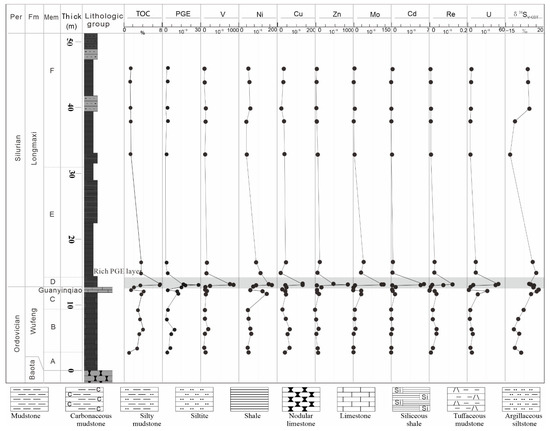
Figure 4.
Trace element characteristics in CN outcrop.
Mo, U, V, Co, Ni, Cu, Zn and other elements form various valence states under different redox conditions, and they are more sensitive to anoxic environments [31]. Additionally, these elements support biological metabolisms and biochemical processes by providing important biological micronutrients or bioessential elements in early life metabolism [32]. Therefore, Mo/TOC, V/Cr, Ni/Co and MOEF-UEF covariant models have been widely used to study the redox state of paleo-oceans, sea basin restriction and primary marine palaeoproductivity [30,31,33]. The enrichment of Mo, U, V, Co, Ni, Cu, Zn and other elements indicated that the sedimentary water in the study area is a reductive environment with high primary paleo-productivity [31,33,34]. Mo and U were significantly enriched in Section D, with an EF greater than 100 (Table 2, Figure 4). The Mo/TOC values in the D and E sections of Longmaxi Fm is significantly higher, with values of 10.15-16.67. In particular, the Mo/TOC in Section D shows a peak value with an average value of 16, which is close to that of Ohio shale in Central Appalachian Basin (Mo/TOC is 12-18) in a semi-retention environment [33]. The mean Mo/TOC of Section B and C of Wufeng Fm is 4.07, similar to that of the Black Sea (mean 4.5), and even lower than that in several samples, which is close to the ratio of the Barnett Fm shale in the Fort Worth Basin, formed in a strong restricted basin environment [35]. This indicates that the organic-rich black shale of the Wufeng Fm and the Longmaxi Fm formed in significantly different environments. The sedimentary period of the Wufeng Fm was a strongly restricted sea basin under an anoxic environment, while the early Longmaxi Fm was a semi-restricted sea basin under an anoxic–suboxic environment [33].
The rare earth elements (REE) of CN outcrop are shown in Table 2. The ∑REE values are 81.77 × 10−6~281.70 × 10−6, with the average of 142.73 × 10−6. This value is close to the average of UCC (146.4 × 10−6) and slightly lower than that of the PAAS (183.03 × 10−6) [23]. The total amount of light rare earth elements (∑LREE) ranges from 72.86 × 10−6 to 260.5 × 10−6, with an average of 128.54 × 10−6, accounting for 90% of the∑REE. The total amount of heavy rare earth elements (∑HREE) is 8.83 × 10−6~21.2 × 10−6, with an average of 14.2 × 10−6, accounting for 10% of the ∑REE. ∑LREE/∑HREE values are 7.25~12.29, the average of 8.96, showing obvious enrichment of LREE and loss of HREE, which is consistent with the distribution law of REE in shale [36]. The values of Eu anomaly (δEuN normalized chondrites) range from 0.65 to 1.29, with an average value of 0.93, showing a wide range of variation, both positive and negative, indicating obvious differentiation compared with chondrites. The values of δEuS (PAAS standardized) ranged from 0.99 to 1.97 with a mean value of 1.42, indicating a positive anomaly. The values of δCeS (PAAS standardized) are 0.76–0.99 with a mean value of 0.89, indicating a weak negative difference. The δEuN positive anomalies reflect the influence of hydrothermal deposition [37,38,39], and the positive anomaly of δEus and the negative anomaly of δCes indicate a reducing sedimentary environment [19,39,40], All the above demonstrate that the Wufeng Fm and Longmaxi Fm in the study area was deposited in a reductive water environment and affected by hydrothermal deposition.
4.3. PGEs Content and Parameter Characteristics
The PGEs contents of black shale are shown in Table 3 and Figure 5, which varies within 2.53 × 10−9~27.64 × 10−9. The content of Pd and Pt was high: the Pd value is 1.53 × 10−9~15.4 × 10−9, with an average of 4.1 × 10–9; and the Pt value is 0.7 × 10−9~9.8 × 10−9, with an average of 2.75 × 10−9. The content of Os, Rh and Ru is low: the Os value is 0.09 × 10−9~1.31 × 10−9, with an average of 0.36 × 10–9; Rh value is 0.04 × 10−9~0.33 × 10−9, with an average of 0.11 × 10−9; and Ru value is 0.16 × 10−9~0.70 × 10−9, with an average of 0.26 × 10−9. Ir content is the lowest, with a value of 0.02 × 10−9~0.43 × 10−9 and an average of 0.08 × 10−9. The Ag content is high, ranging within 0.097 × 10−6~3.09 × 10−6, with an average of 0.56 × 10−6. The Au content of five samples in Section C-D is also measured. The sampling position of Au is shown in Figure 2b. The Au content of one sample in Section D is 4.27 × 10−9, three samples of Guanyinqiao Mem have Au contents of 2.01 × 10−9, 2.04 × 10−9, and 3.51 × 10−9, and the Au content of one sample in the Section C of Wufeng Fm is 2.79 × 10−9.

Table 3.
PGEs and relevant parameters of CN outcrop.
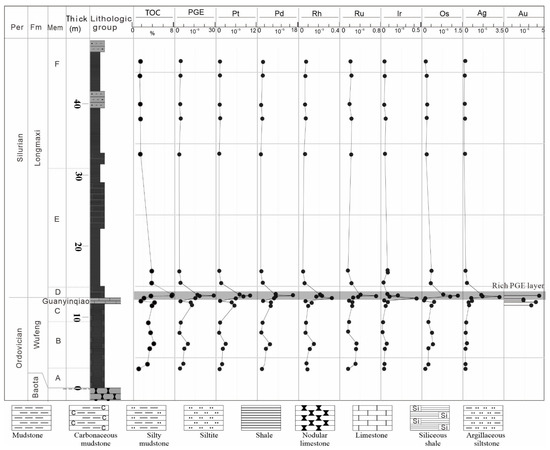
Figure 5.
Characteristics of PGEs in CN outcrop.
Compared with the average content of the UCC [6,42], the CN outcrop black shale is relatively rich in PGEs (Figure 6). Compared with the Cambrian black samples in the Chengkou area [7], the contents of others show similar characteristics except that Pd and Ru are significantly lower. Compared with the Cambrian black rock series in Hunan and Guizhou [43], other elements show similar features except that Ru is slightly higher and Ir is slightly lower. In addition, the samples of the polymetallic enrichment layer of the black rock series (Section D) in this area are relatively rich in Ag and Au, which are 27 times and two times the abundance of the UCC, respectively [42]. It can be seen from the element profile histogram that the PGEs enrichment layer is mainly distributed in Section D from Section C at the top of the Wufeng Fm to the bottom of the Longmaxi Fm. The PGEs contents in other sections of the profile are low.
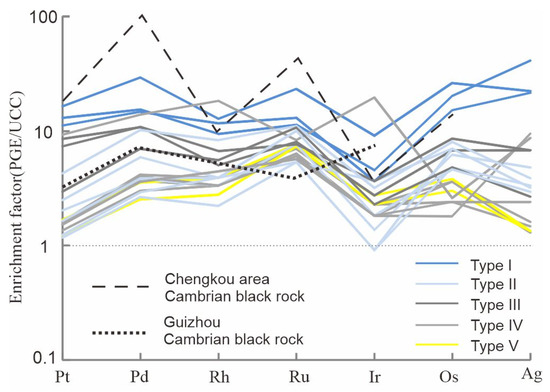
Figure 6.
Enrichment factors of PGEs in the Longmaxi Fm black shale in CN outcrop normalized to the UCC [6].
PGEs have certain distribution laws in different spheres of Earth. Generally, there are three kinds of distribution modes: Ru–Pt, Ru–OS and Pt–Pd [6,44]. The distribution of PGEs in the study area has an obvious Pt–Pd pattern, Pd > Pt, and the content of Pd is much higher than Ru, Rh, Os and Ir. In general, the Pt/Pd of the whole profile is less than one, in which of PGEs enrichment layer (Section C and D) Pt/Pd≈ 1:1, while in Section A, B, E and F it is Pt/Pd ≈ 1:2. The mean values of Pt/Ir, Pt/Ru and Pd/Pt of PGEs enrichment layers (Sections C+ D) are 4.60, 3.47 and 6.07, respectively, which are far greater than the corresponding original mantle values of 1.21, 1.44 and 0.55 [45] and C1 chondrite values of 1.22, 1.42 and 0.54 [45], indicating that the source of PGEs may not be the original mantle or C1 chondrite. In addition, the Pd/Ir value can best verify the fractionation effect of PGEs. The Pd/Ir value of the PGEs enrichment layer is 72.96, which indicates strong fractionation.
5. Discussion
5.1. Extraterrestrial Matter Influences
The source of PGEs in the black rock series is a research hotspot at present. Predecessors have performed much research on the source of PGEs in the black rock series, which has been widely developed due to the paleo-oceanic anoxic event at the turn of the Precambrian–Cambrian boundary [4,9,43,46]. Fan et al. (1973, 2004) [47,48] proposed that Ni, Co and PGEs may be extraterrestrial sources and trace elements such as Mo, Zn, Pb, Ba and V may be the origin of submarine hot springs according to the Ir anomaly and the distribution of PGEs. Coveney et al. (1991, 2012) [10,49], Li et al. (2000) [50] and Mao et al. (2001) [51] think that it is mainly related to submarine hydrothermal effusion. Han (2015) [42] thinks that it comes from hot brine rich in organic matter, that is, the organic matter and hot brine mode [52]. Liang et al. (1997) [53] put forward a conclusion similar to that of Fan et al. (1973) [47] that the Mo–Ni–PGEs metal layer is of typical syngenetic sedimentary origin, and PGEs enrichment is related to carbonaceous adsorption in addition to sulfide. In conclusion, the previous viewpoints on the genesis of PGEs in the Cambrian black rock series mainly focus on the origin of extraterrestrial materials, the origin of normal seawater and the origin of hot water.
Ir in PGEs can provide important information on rock genesis, and Ir anomalies are considered to be affected by the impact of extraterrestrial objects on the earth [25,54,55]. The Ir content of black shale in CN outcrop is low (Table 3), ranging from 0.02 × 10−9 to 0.43 × 10−9, with an average of 0.080 × 10−9. The Ir value of PGEs enrichment layer (Section D) is slightly higher, and the value is 0.1 × 10−9~0.43 × 10−9 but also significantly lower than the Ir content of the Cretaceous Tertiary boundary clay layer in Denmark with typical extraterrestrial genesis (47 × 10−9) [54,55,56] and primitive mantle values (Ir =3.2 × 10−9) [23], and similar to the Ir value of Ni-Mo layer in Niutitang Fm (measured by [10] ranged from 0.02 × 10−9~0.15 ×10−9and the Cambrian black shale in Chengkou area [7] value is 0.05 × 10−9~0.15 × 10−9,and there is no obvious abnormally high value of Ir. Therefore, it can be considered that PGEs in the black shale of the Wufeng Fm and Longmaxi Fm Fm does not have the characteristics of extraterrestrial material sources.
Carbonaceous chondrites can be regarded as representative of extraterrestrial materials. The mean value of Pd/Pt, (Pt + Pd)/(Os + Ru + Ir), Au/Ir, and Ag/Au in carbonaceous chondrites are 0.57, 0.86, 0.31 and 1.14, respectively [57,58]. However, those values in the D Section are 1.26, 10.36, 21, and 500, respectively, which is not comparable. Therefore, it is speculated that these PGEs are not from extraterrestrial materials. As show in Ir/Pt–Pd/Pt discrimination diagram [25] (Figure 7), the sample points with TOC > 2% (type I, type II, type III) and TOC < 2% (type IV, type V) are obviously zoned but are far from chondrites [45] and clay rocks at the Cretaceous-Paleogene (K/Pg) boundary that are obviously affected by extraterrestrial materials [56], which again shows that the PGEs in the study area do not have extraterrestrial material source characteristics.
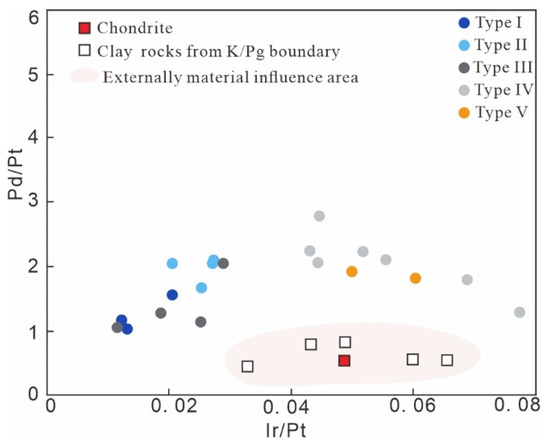
Figure 7.
Ir/Pt–Pd/Pt discrimination diagram of CN outcrop [25].
5.2. Influence of Hydrothermal Deposition
With the deepening of shale gas exploration in the Sichuan Basin, many scholars have carried out much research on the origin of organic matter-rich black shale in the upper Wufeng Fm and Longmaxi Fm from different aspects, such as paleontology, elemental geochemistry and isotopes [51,59]. Up to now, it is still controversial whether the black shale deposition of the Wufeng Fm and Longmaxi Fm in the upper Yangtze region is affected by hydrothermal fluid. Some scholars believe that the high siliceous black shale of the Wufeng Fm and Longmaxi Fm is mainly of biological origin and lack of hydrothermal origin [59,60]. However, some studies also indicate that the black shale was affected by hydrothermal deposition [61]. According to the SiO2–Al2O3 discrimination diagram (Figure 8) [62], the samples of Section C fall into the normal seawater deposition area, while the sample of Section D of the PGEs enrichment layer falls into the junction of hot water and normal seawater deposition areas, indicating that the shale in Section D may be affected by hydrothermal activity during deposition, and the enrichment of PGEs may be related to hydrothermal sedimentation. At the same time, other sample points are located in both areas, which indicates that the black shale may have been affected by hydrothermal activity during the deposition period.
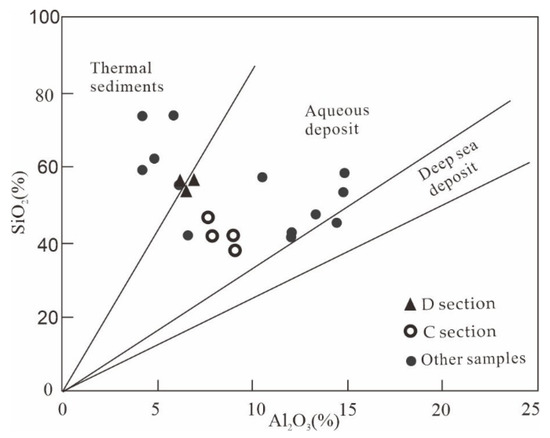
Figure 8.
SiO2/Al2O3 diagram of CN outcrop [62].
In general, typical hydrothermal deposits have low REE, LREE enrichment and obvious positive Eu anomalies [63]; high concentrations of the trace elements Mo, Sb, U, Cd, V, Ba, Ni, Cr, Cu, Zn, and Bi and the strong loss of Sr may also be related to hydrothermal activities [40,64]. The REE of black shale in CN outcrop show obvious LREE enrichment, and some samples show positive Eu anomalies (Table 2). Moreover, Mo, U, V, Ba, Ni, Cr, Cu, Zn and other elements are enriched, and Sr is depleted. The above element characteristics indicate that the study area is affected by hydrothermal deposition.
Previous studies have shown that the typical Kuroko massive sulfide deposit and the Cambrian black rock series in Chengkou [7], RM black chimney [65], Guizhou Ni Mo ore [9] and Yangliuping PGEs ore [66] are involved in the enrichment of PGEs in hydrothermal genesis. On the standardized distribution pattern map of PGEs chondrites (Figure 9), the Section C and Section D of the black rock series in the study area are obviously differentiated, and the Ir presents an obvious low value. This is distinct from the PGEs distribution pattern with flat sources of extraterrestrial materials [25,45] but has a similar distribution trend with the typical Kuroko massive sulfide deposit, RM black chimney and Chengkou Cambrian black rock series. It is slightly lower than that of Ni–Mo ore and Yangliuping PGEs ore in Guizhou, which is quite different from the normal seawater sedimentation distribution mode [9], which again shows that the genesis of the black rock series of the Wufeng Fm and Longmaxi Fm is not caused by extraterrestrial materials but affected by hydrothermal deposition.
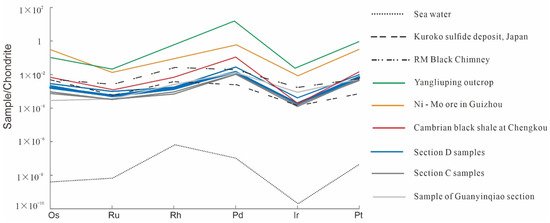
Figure 9.
Chondrite-normalized patterns of PGEs in the Wufeng Fm and Longmaxi Fm black rocks in CN outcrop.
Scheme 2007. Kuroko sulfide deposit of Japan and Cambrian black shale at Chengkou are from [7]; RM Black Chimney and Yangliuping outcrop are from [65,66], respectively.
Element Pd and Ir have different geochemical behaviors in magma and hydrothermal fluid. Ir does not easily migrate in hydrothermal fluid, so hydrothermal sulfide has lower Ir content and higher Pd/Ir ratios, while magmatic sulfide ore has relatively lower values, so the Pd/Ir value is usually used to indicate hydrothermal alteration of ore genesis [66]. For example, the average Ir value of the Pacific black chimney is 0.7-0.8 ng/g, and the Pd/Ir ratio is 12.4-231.9 [65]. The Ir content in the study area is low, with an average of 0.08 ng/g (the average value of the D section is 0.13 ng/g), and the Pd/Ir ratio is 17-101 (Table 3, the average value of the D section is 85), with a wide range of variation, showing the genetic characteristics of hydrothermal influence [65]. It can be seen that the black shale of CN outcrop and the Cambrian black shale of Chengkou [7] and the Ni–Mo ore in Guizhou [9] and the Ni–Mo–Zn ore in Canada [67] fell in the same range (Figure 10), while the oceanic Fe–Mn crusts [68] fell in another region, which also shows the result of the participation of hydrothermal activity in the sedimentary period.
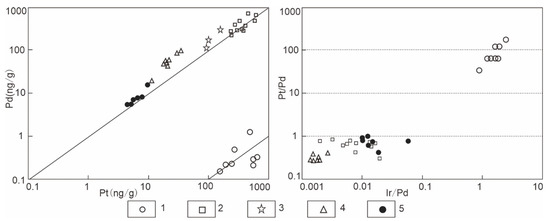
Figure 10.
Pt–Pd and Pt/Pd–Ir/Pd diagram for black shale in CN outcrop. 1. Fe–Mn crusts [68]; 2. Ni–Mo ore in Guizhou [9]; 3. Ni–Mo–Zn ore, Canada [67]; 4. Cambrian black shale in Chengkou [7]; 5. CN outcrop (Section C and D).
5.3. Biological Sedimentation
Previous studies have shown that bio-organic matter plays an important role in the enrichment and accumulation of elements in both seawater and hydrothermal mineralization [69,70]. In carbonaceous rocks, the chemical adsorption ability of carbonaceous-activated organic matter becomes an effective mechanism for PGEs accumulation [71] (A large number of organisms developed during the early stage of sedimentation and diagenesis, such as algae and plankton, constantly absorbed nutrients from the surrounding environment and concentrated PGEs, Au, Ag, V, Mo, Ni and other metal elements. Later, a large number of biological remains were degraded by bacteria to produce a large amount of humic acid (the precursor of kerogen), and the CO2 and CH4 produced at the same time kept the sedimentary interface in a continuous and stable reduction state, which is not only conducive to the full adsorption and precipitation of metal elements by the sediments, but also effectively prevents the organic complexes of the precipitated metals from being released again and participating in the circulation activities of the ocean [72]. Therefore, the organic-rich black shale is rich in a variety of metal elements [7,43,73]. Among them, the PGEs enrichment layer is subjected to the strongest hot water action, and the thermal evolution of organic matter is enhanced. During this process, kerogen continuously concentrates and adsorbs precious metal ions such as PGEs, Au and Ag, so the PGEs enrichment layer corresponds to a high TOC value [43,58].
The TOC of the middle and upper part of the Wufeng Fm (Section B and C) and the early stage of the Longmaxi Fm (Section D and E) are more than 2%. A large number of graptolite, brachiopod bivalves and other fossils can be directly seen in black shale, and radiolaria and other microbial fossils can be seen under the microscope (Figure 3). Especially in Section D, the TOC value is higher than 7%, which corresponds to the high value of PGEs, and the trace elements Re, Mo, Cd, Ni, V, U, Cu, Zn and δ 34SV-CDT also showed high mutation values (Figure 4). It can be seen from the correlation diagram (Figure 11) that PGEs has excellent correlation with TOC, R2 value is 0.5675, and has excellent correlation with Cu, Zn, Ni, Mo, V, U and other elements (R2 value is 0.5397, 0.6375, 0.5893, 0.5039, 0.6139, 0.5351, respectively), indicating that PGEs enriched in marine shale may be associated with not only the sedimentary carbonaceous matter related to biological processes, but also to the mineralization of some molybdenum sulfide nickel ore and pyrite [35,58,74,75].
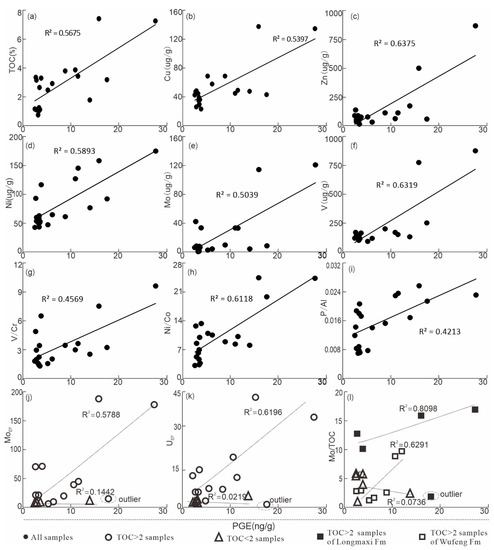
Figure 11.
Linear relationship between PGE with elements and parameters. (a) PGE-TOC linear relationship diagram; (b) PGE-Cu linear relationship diagram; (c) PGE-Zn linear relationship diagram; (d) PGE-Ni linear relationship diagram; (e) PGE-Mo linear relationship diagram; (f) PGE-V linear relationship diagram; (g) PGE-V/Cr linear relationship diagram; (h) PGE-Ni/Co linear relationship diagram; (i) PGE-P/Al linear relationship diagram; (j) PGE-MoEF linear relationship diagram; (k) PGE-UEF linear relationship diagram; (l) PGE-Mo/TOC linear relationship diagram.
5.4. Indicative Significance of Sedimentary Environment
Previous studies have shown that the formation and preservation of organic-rich shale with high TOC are complex physical and chemical processes. Many scholars attempted to study the main factors that control these processes and proposed relevant influences on the burial and preservation of organic matter in sediments [31,76]. At present, it is believed that factors including primary paleo-productivity of the ocean and bottom water redox conditions in a periodically stratified marine basin, paleoclimate, sedimentation rate, terrigenous flux, paleosalinity and subsequent tectonic movement play an important role in the enrichment and preservation of organic materials [31,76,77]. Previous studies have shown that the degree of restriction in the Sichuan Basin differed during Wufeng and Longmaxi periods. The restriction of Wufeng Fm is similar to the Black Sea basin, which is a strong restricted basin, while the Longmaxi Fm is a semi-restricted basin. The high TOC in the Wufeng Fm mainly benefited from the slow rate of water exchange resulting from the strong restricted basin during the period of marine retreat, which was conducive to the preservation of organic matter. In contrast, the high TOC in the Longmaxi Fm mainly benefited from the anoxic sedimentary environment caused by the rise in sea level, which controlled the enrichment of organic matter in the semi-restricted basin. However, the PGEs-enrichment layer happens to be located at the sedimentary transition boundary of the Wufeng Fm and Longmaxi Fm. At the period of O-S transition, the Gondwana glacier event ends, accompanied by mass extinction events, and volcanic events spread all of the Sichuan basin. The obvious enrichment of PGEs effectively indicates the environmental mutation of the O-S boundary. This finding suggested that at that time the sedimentary environment is not only conducive to the enrichment of organic matter, but also to the preservation. Thus, PGEs and metal element enrichment layer with high TOC in the D section was formed.
According to the results of this study, many organisms are developed in PGEs rich layer (Section D), which corresponded to high palaeo-productivity (Figure 12). PGEs and paleo-productivity index P/Al [78,79] were strongly correlated with the R2 value of 0.4213 (Figure 11i, Figure 12). In addition, PGEs was strongly correlated with the paleoredox proxies V/Cr and Ni/Co (Figure 11g,h). The R2 values were 0.4569 and 0.6118, indicating that PGEs was enriched in the anoxic water environment. The correlations between PGEs and the parameters for the degree of basin restricted MoEF, UEF and Mo/TOC were excellent when TOC > 2% (Figure 11j–l). The R2 values were 0.5788, 0.6196 and 0.4332, which indicated that PGEs is similar to Mo and U and was strongly correlated with the TOC. It is speculated that the enrichment of PGEs may have been affected by the degree of basin restriction. Moreover, Mo/TOC were obviously distributed differently from he Wufeng Fm and Longmaxi Fm (Figure 11l), and both were strongly correlated with PGEs (R2 values were 0.6291, 0.8098). It indicated that the basin has different limitations during the Wufeng and Longmaxi periods [80]. In addition, it can be seen in Figure 12 that PGEs rich layer (Section D) corresponded to the anoxic environment with strong restriction, high palaeo-productivity and low terrigenous flux [19,57]. However, the enrichment of PGEs was as complex as the enrichment of the TOC, which was controlled by the influence of the paleoenvironment. However, it is undeniable that the anoxic water body and high primary paleo-productivity in the restricted basin were the main factors that contributed to PGEs enrichment. It could also be related to extinctions caused by abrupt climate changes or strong tectonic movements. Additionally, the positive correlation between TOC and PGEs indicates that the PGEs may be used as an indicator of sedimentary environment, just like characteristic trace elements and REE.
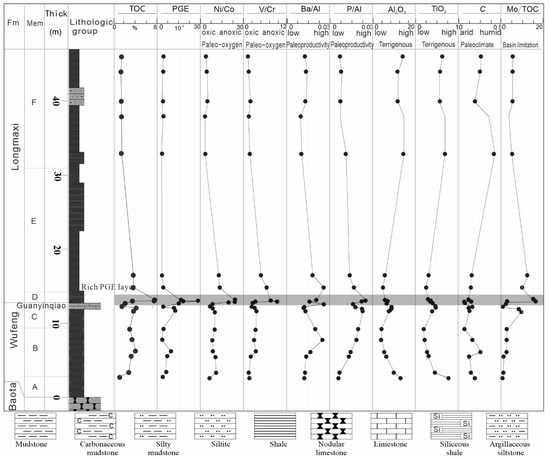
Figure 12.
Stratigraphic profiles of CN outcrop for correlation between PGEs and high TOC main controlling factors.
6. Conclusions
- The black shale of the Wufeng Fm and Longmaxi Fm in the CN outcrop has a high TOC and SiO2 content. A large number of radiolarian fossils have been found, indicating that they are mainly biogenic siliceous. The content of PGEs is low, relatively rich in Pt and Pd, and deficient in Ir and Ru, with an obvious Pt–Pd distribution pattern. PGEs is mainly enriched in the bottom of Longmaxi Fm, and Mo, Ni, V, U, Cu, Zn and other elements are enriched at the same time, which indicates that the sedimentary period of this period is not only the normal seawater deposition, but may be affected by submarine hydrothermal sedimentation.
- There is no obvious abnormality in Ir whose content is low, which is significantly less than that of the Cretaceous–Paleogene boundary clay layer in Denmark with typical extraterrestrial genesis. Meanwhile, there is no comparability with the values of Pd/Pt, (Pt + PD)/(OS + Ru + IR), Au/Ir and Ag/Au in carbonaceous chondrites, indicating that PGEs of the black shale is not an extraterrestrial material source.
- The trace elements Mo, Sb, V, Ba, Ni, Cr, Cu, Zn enrichment and Sr deficiency, LREE enrichment, partial samples δEun positive anomaly, the normalized PGEs distribution pattern of chondrite, the Pd/Ir and the Pt/Pd–Ir/Pd correlation diagram all show that the enrichment of PGEs is closely related to the seafloor hydrothermal process.
- PGEs and TOC, Mo, Ni, Cu, Zn and δ 34SV-CDT correlations indicate that PGEs enrichment is related not only to organic matter enrichment but also to Mo, Ni sulfide and pyrite. This may be related to the enrichment of mantle-derived materials brought by submarine hydrothermal solution in the early Longmaxi Fm. PGEs enrichment is complex and controlled by the influence of the sedimentary environment. The anoxic water body and high primary paleo-productivity in the restricted basin and hydrothermal sedimentary influence are the main factors. It could also be related to extinctions caused by abrupt climate changes or strong tectonic movements. In addition, the good positive correlation between TOC and PGEs indicates that PGEs may be used as an indicator parameter for the sedimentary environment and organic matter enrichment.
Author Contributions
Conceptualization, Q.Z. and Y.M.; methodology, Q.Z.; software, Y.M.; validation, Q.Y., G.W. and Y.X.; formal analysis, Q.Z. and Y.M.; investigation, H.Z., A.Z., Y.Z. and J.C.; resources, Q.Y., G.W.; data curation, Q.Z.; writing—original draft preparation, Q.Z.; writing—review and editing, Q.Z. and Y.M.;. supervision, Q.Y. and A.Z.; project administration, Q.Y.; funding acquisition, Q.Y., H.Z., A.Z. and Y.Z. All authors have read and agreed to the published version of the manuscript.
Funding
This research was funded by the National Science and Technology Major special Project “Shale Gas Exploration and Evalua-tion Technology Test and Application Promotion“. Project No.: 2016ZX05034-004; Study on Cambrian-Silurian structural-sedimentary difference, shale gas enrichment rules and regional optimization in the southern margin of Sichuan Basin. Project No.: CCL2021RCPS0073ESN; Shale Gas Exploration Practice in North Guizhou Exploration of Shale Gas Resource Potential in Niutitang Formation of Lower Cambrian. Project No.: 35450003-20-ZC0613-0003.
Acknowledgments
We thank the journal reviewers for their very constructive and helpful comments, which helped to improve the manuscript.
Conflicts of Interest
The authors declare no conflict of interest.
References
- Barnes, S.J.; Naldrett, A.J.; Gorton, M.P. The origin of the fractionation of platinum-group elements in terrestrial magmas. Chem. Geol. 1985, 53, 303–323. [Google Scholar] [CrossRef]
- Gadd, M.G.; Peter, J.M.; Jackson, S.E.; Yang, Z.; Petts, D. Platinum, Pd, Mo, Au and Re deportment in hyper-enriched black shale Ni-Zn-Mo-PGE mineralization, Peel River, Yukon, Canada. Ore Geol. Rev. 2019, 107, 600–614. [Google Scholar] [CrossRef]
- Liang, Y.; Zhu, W. Disscussion on the enrichment characteristics of PGE, REE and the genesis for Ni-Mo ore deposits in Tianmenshan area northwest Hunan province. Contrib. Geol. Miner. Resour. Res. 1995, 10, 55–65, (In Chinese with English abstract). [Google Scholar]
- Yi, F.; Gao, Z. The geological and geochemical charaterstics of Platinum-group element in black rock series. Adv. Earth Sci. 1996, 11, 275–281. [Google Scholar]
- Zhang, G.; Li, J.; Xiong, Q.; Qi, F.; Zhen, M. Enrichment Features and Patterns of PGE Metals in BlackShale from Zunyi area, Guizhou Province. Miner. Depos. 2002, 21, 377–386, (In Chinese with English abstract). [Google Scholar]
- Park, J.W.; Hu, Z.; Gao, S.; Campbell, I.H.; Gong, H. Platinum group element abundances in the upper continental crust revisited—New constraints from analyses of Chinese loess. Geochim. Et Cosmochim. Acta 2012, 93, 63–76. [Google Scholar] [CrossRef]
- Zhu, Z.; Zhang, B.; Tang, Q.; Mao, L.; Shuang, Y.; Zhang, X. Sources and Geochemistry of Platinum Group Elements (PGE) in the Early Cambrian Black Rock Series in Chengkou District, Northern Dabashan. Southwest China 2017, 37, 495–506, (In Chinese with English abstract). [Google Scholar]
- Wang, J.; Ceng, P.; Ma, J. Black Rock Series and Associated Minerals: An Example of the Yangtze Platform. Geol. Explor. 2015, 51, 677–689, (In Chinese with English abstract). [Google Scholar]
- Jiang, S.; Yang, J.; Ling, H.; Chen, Y.; Feng, H.; Zhao, K.; Ni, P. Extreme enrichment of polymetallic Ni–Mo–PGE–Au in Lower Cambrian black shales of South China: An Os isotope and PGE geochemical investigation. Palaeogeogr. Palaeoclimatol. Palaeoecol. 2007, 254, 217–228. [Google Scholar] [CrossRef]
- Coveney, R.M.; Murowchick, J.B.; Grauch, R.I. Gold and platinum in shales with evidence against extraterrestrial sources of metals. Chem. Geol. 2012, 99, 101–114. [Google Scholar] [CrossRef]
- Zou, C.; Dong, D.; Wang, S.; Li, J.; Li, X.; Wang, Y.; Li, D.; Cheng, K. Geological characteristics, formation mechanism and resourcepotential of shale gas in China. Pet. Explor. Dev. 2010, 37, 641–653, (In Chinese with English abstract). [Google Scholar] [CrossRef]
- Wang, S.; Dong, D.; Wang, Y.; Li, X.; Huang, J.; Guan, Q. Sedimentary geochemical proxies for paleoenvironment interpretation of organic-rich shale: A case study of the Lower Silurian Longmaxi Formation, Southern Sichuan Basin, China. J. Nat. Gas Sci. Eng. 2016, 28, 691–699. [Google Scholar] [CrossRef]
- Gao, J.; Wang, X.; He, S.; Guo, X.; Zhang, B.; Chen, X. Geochemical characteristics and source correlation of natural gas in Jurassic shales in the North Fuling area, Eastern Sichuan Basin, China. J. Petrol. Sci. Eng. 2017, 158, 284–292. [Google Scholar] [CrossRef]
- Nie, H.; Jin, Z.; Ma, X.; Liu, Z.; Lin, T.; Yang, Z. Graptoliteszone and sedimentary characteristics of Upper Ordovician Wufeng formation-Lower Silurian Longmaxi Formation Sichuan basin and its adjacent areas. Acta Pet. Sin. 2017, 38, 160–174, (In Chinese with English abstract). [Google Scholar]
- Tang, X.; Jiang, Z.; Huang, H.; Jiang, S.; Yang, L.; Xiong, F.; Chen, L.; Feng, J. Lithofacies characteristics and its effect on gas storage of the Silurian Longmaxi marine shale in the southeast Sichuan Basin, China. J. Nat. Gas Sci. Eng. 2016, 28, 338–346. [Google Scholar] [CrossRef]
- Tuo, J.; Wu, C.; Zhang, M. Organic matter properties and shale gas potential of Paleozoic shales in Sichuan Basin, China. J. Nat. Gas Sci. Eng. 2016, 28, 434–446. [Google Scholar] [CrossRef]
- Yang, R.; He, S.; Hu, Q.; Hu, D.; Yi, J. Geochemical characteristics and origin of natural gas from Wufeng-Longmaxi shales of the Fuling gas field, Sichuan Basin (China). Int. J. Coal Geol. 2017, 171, 1–11. [Google Scholar] [CrossRef]
- Zhao, J.; Jin, Z.; Jin, Z.; Geng, Y.; Wen, X.; Yan, C. Applying sedimentary geochemical proxies for paleoenvironment interpretation of organic-rich shale deposition in the Sichuan Basin, China. Int. J. Coal Geol. 2016, 163, 52–71. [Google Scholar] [CrossRef]
- Wang, S.; Sun, X.; Shi, G. Distinction of Platinum Group Elements ( PGE) Geochemistry between the Jinbaoshan and Baimazhai Magmatic Sulf ide Deposits in Yunnan Province, China, and Its Impl ication for Ore Genesis. Acta Geol. Sin. 2007, 81, 93–108, (In Chinese with English abstract). [Google Scholar]
- Luo, Q.; Zhong, N.; Dai, N.; Zhang, W. Graptolite-derived organic matter in the Wufeng–Longmaxi Formations (Upper Ordovician–Lower Silurian) of southeastern Chongqing, China: Implications for gas shale evaluation. Int. J. Coal Geol. 2016, 153, 87–98. [Google Scholar] [CrossRef]
- Li, Y.; Zhang, T.; Ellis, G.S.; Shao, D. Depositional environment and organic matter accumulation of Upper Ordovician–Lower Silurian marine shale in the Upper Yangtze Platform, South China. Palaeogeogr. Palaeoclimatol. Palaeoecol. 2017, 466, 252–264. [Google Scholar] [CrossRef]
- Liu, H.; Jin, G.; Li, J.; Han, J.; Zang, J.; Zhang, J.; Zhong, F.; Guo, D. Determinationof stable isotope composition in uranium geological samples. World Nucl. Geosci. 2013, 30, 174–179, (In Chinese with English abstract). [Google Scholar]
- Taylor, S.R.; McLennan, S.M. The Continental Crust: Its Composition and Evolution; Blackwell Scientific Publication: Oxford, UK, 1985. [Google Scholar]
- Wang, Y.; Dong, D.; Huang, J.; Li, X.; Wang, S. Guanyinqiao Member lithofacies of the Upper Ordovician Wufeng Formationaround the Sichuan Basin and the significance to shale gas plays, SW China. Pet. Explor. Dev. 2016, 43, 42–50, (In Chinese with English abstract). [Google Scholar] [CrossRef]
- Zhou, M.; Luo, T.; Huff, W.D.; Liu, S. Prominent Lower Cambrian K-Bentonites In South China: Distribution, Mineralogy, and Geochemistry. J. Sediment. Res. 2014, 84, 842–853. [Google Scholar] [CrossRef]
- Tribovillard, N.; Algeo, T.J.; Lyons, T.; Riboulleau, A. Trace metals as paleoredox and paleoproductivity proxies: An update. Chem. Geol. 2006, 232, 12–32. [Google Scholar] [CrossRef]
- Tribovillard, N.; Algeo, T.J.; Baudin, F.; Riboulleau, A. Analysis of marine environmental conditions based onmolybdenum–uranium covariation—Applications to Mesozoic paleoceanography. Chem. Geol. 2012, 324–325, 46–58. [Google Scholar] [CrossRef]
- Taylor, S.R.; McLennan, S.M. The geochemical evolution of the continental crust. Rev. Geophys. 1995, 33, 241–265. [Google Scholar] [CrossRef]
- Algeo, T.J.; Tribovillard, N. Environmental analysis of paleoceanographic systems based on molybdenum–uranium covariation. Chem. Geol. 2009, 268, 211–225. [Google Scholar] [CrossRef]
- Tang, D.; Shi, X.; Zhao, X. Mo-U Covariation as An Important Proxy for Sedimentary Environment, Redox Conditions-Progress, Problems and Prospects. Geoscience 2015, 29, 1–13, (In Chinese with English abstract). [Google Scholar]
- Algeo, T.J.; Morford, J.; Cruse, A. Reprint of: New Applications of Trace Metals as Proxies in Marine Paleoenvironments. Chem. Geol. 2012, 324–325, 1–5. [Google Scholar] [CrossRef]
- Anbar, A.D. OCEANS: Elements and Evolution. Science 2008, 322, 1481–1483. [Google Scholar] [CrossRef] [PubMed]
- Li, Y.; LÜ, H.; Zhang, Y.; Zhang, X.; Shao, D.; Yan, J.; Zhang, T. U-Mo covariation in marine shales of Wufeng—Longmaxi Formations in Sichuan Basin. Geochimica 2015, 44, 109–116, (In Chinese with English abstract). [Google Scholar]
- Algeo, T.J.; Lyons, T.W. Mo–total organic carbon covariation in modern anoxic marine environments: Implications for analysis of paleoredox and paleohydrographic conditions. Paleoceanography 2006, 21, 279–298. [Google Scholar] [CrossRef]
- Rowe, H.D.; Loucks, R.G.; Ruppel, S.C.; Rimmer, S.M. Mississippian Barnett Formation, Fort Worth Basin, Texas: Bulk geochemical inferences and Mo–TOC constraints on the severity of hydrographic restriction. Chem. Geol. 2008, 257, 16–25. [Google Scholar] [CrossRef]
- Gromet, L.P.; Haskin, L.A.; Korotev, R.L.; Dymek, R.F. The “North American shale composite”: Its compilation, major and trace element characteristics. Geochim. Cosmochim. Acta 1984, 48, 2469–2482. [Google Scholar] [CrossRef]
- Sugitani, K.; Yamashita, F.; Nagaoka, T.; Yamamoto, K.; Minami, M.; Mimura, K.; Suzuki, K. Geochemistry and sedimentary petrology of Archean clastic sedimentary rocks at Mt. Goldsworthy, Pilbara Craton, Western Australia: Evidence for the early evolution of continental crust and hydrothermal alteration. Precambrian Res. 2006, 147, 124–147. [Google Scholar] [CrossRef]
- Bai, Y.; Liu, Z.; Sun, P.; Liu, R.; Hu, X.; Zhao, H.; Xu, Y. Rare earth and major element geochemistry of Eocene fine-grained sediments in oil shale- and coal-bearing layers of the Meihe Basin, Northeast China. J. Asian Earth Sci. 2015, 97, 89–101. [Google Scholar] [CrossRef]
- Zhang, Q.; Yu, Q.; Wang, J.; Xiao, Y.; Cheng, J.; Zhao, A.; Zhang, B. Application of ICP-MS to study the Rare Earth Element characteristics and sedimentary environment of black shale in the Longmaxi formation in the Southwestern Sichuan Basin. Rock Miner. Anal. 2018, 37, 217–224, (In Chinese with English abstract). [Google Scholar]
- Yang, B.; Bin, H.; Bao, Z.; Zhang, Z. REE geochemical characteristics and depositional environment of the black shale-hosted Baiguoyuan Ag-V deposit in Xingshan, Hubei Province, China. J. Rare Earths 2011, 29, 499–506. [Google Scholar] [CrossRef]
- Haskin, L.; Wildeman, T.; Haskin, M. An accurate procedure for the determination of the rare earths by neutron activation. J. Radioanal. Chem. 1968, 1, 337–348. [Google Scholar] [CrossRef]
- Li, T. The statistieal charaeteristies of the abundanceof chemical elements in the Earth’s Crust. Geolegy Prospect. 1992, 28, 3–9, (In Chinese with English abstract). [Google Scholar]
- Han, T.; Zhu, X.; Li, K.; Jiang, L.; Zhao, C.; Wang, Z. Metal sources for the polymetallic Ni–Mo–PGE mineralization in the black shales of the Lower Cambrian Niutitang Fm, South China. Ore Geol. Rev. 2015, 67, 158–169. [Google Scholar] [CrossRef]
- Tu, G. Research on the material composition, geological background and some peculiarities of formation mechanism of unconventional super-large ore deposit—An initial discussion on unconventional super-large ore deposit. J. Sci. China Ser. D 1998, 1–6. [Google Scholar]
- Mcdonough, W.F.; Sun, S.S. The composition of the Earth. Chem. Geol. 1995, 120, 223–253. [Google Scholar] [CrossRef]
- Han, T.; Zhu, X.; Chen, N. Occurrence of PGE in the Polymetal lic Layer of Black Shales, Zunyi, Guizhou, China. Bull. Mineral. Petrol. Geochem. 2011, 30, 142–149, (In Chinese with English abstract). [Google Scholar]
- Fan, D.; Yang, X.; Wang, L.; Chen, N. Petrological and geochemical characteristics of a nickel-molybdenum-multe-element-beaing lower-Cambrian black shale from a certain district in south China. Geochemical 1973, 3, 3–24, (in Chinese with English abstract). [Google Scholar]
- Fan, D.; Zhang, T.; Ye, J. Black Rock Series and Related Mineral Deposits in China; Science Press: Beijing, China, 2004; (In Chinese with English abstract). [Google Scholar]
- Coveney, R.M.; Nansheng, C. Ni-Mo-PGE-Au-rich ores in Chinese black shales and speculations on possible analogues in the United States. Miner. Depos. 1991, 26, 83–88. [Google Scholar] [CrossRef]
- Li, S.; Gao, Z. Tracing of noble metal elements in the black rock series of the Cambrian bottom of Hunan, Guizhou and Guizhou. Sci. China: Geosci. 2000, 30, 169–174, (In Chinese with English abstract). [Google Scholar]
- Mao, J.; Zhang, G.; Du, A.; Wang, Y.; Zeng, M. Geology, Geochemistry, and Re-Os isotopie dating of the Huang Jiawan Ni-Mo-PGE deposite, Zunyi, Guizhou Province-with a discussion of the polymetallie mineralization of basal Cambrian black shale in south China. Acta Geol. Sin. 2001, 75, 234–243, (In Chinese with English abstract). [Google Scholar]
- Xiao, Q.; Li, S.; Cai, K. Features of platinrm-group element in different mineral assemblages in the Lower Cambrian black rock series in Hunan and Guizhou. Geolegy China 2006, 33, 1083–1091, (In Chinese with English abstract). [Google Scholar]
- Liang, Y.; Li, Y. Genetic types and geological characteristics of platinum group element deposits in China. Miner. Resour. Geol. 1997, 11, 145–151, (In Chinese with English abstract). [Google Scholar]
- Ganapaty, R. A Major Meteorite Impact on the Earth 65 Million Years Ago: Evidence from the Cretaceous-Tertiary Boundary Clay. Science 1980, 209, 921–923. [Google Scholar] [CrossRef] [PubMed]
- Alvarez, L.W.; Alvarez, W.; Asaro, F.; Michel, H.V. Extraterrestrial Cause for the Cretaceous-Tertiary Extinction. Science 1981, 208, 1095–1108. [Google Scholar] [CrossRef] [PubMed]
- Kyte, F.T.; Smit, J.; Wasson, J.T. Siderophile interelement variations in the Cretaceous-Tertiary boundary sediments from Caravaca, Spain. Earth Planet. Sci. Lett. 1985, 73, 183–195. [Google Scholar] [CrossRef]
- Liu, Z.; Algeo, T.J.; Guo, X.; Fan, J.; Du, X.; Lu, Y. Paleo-environmental cyclicity in the Early Silurian Yangtze Sea (South China): Tectonic or glacio-eustatic control? Palaeogeogr. Palaeoclimatol. Palaeoecol. 2017, 466, 59–76. [Google Scholar] [CrossRef]
- Wang, M. Research Status and Prospect of Determination of Platinum Group Elements. Rare Metal Materials and Engineering. 2010, 39, 2255–2261, (In Chinese with English abstract). [Google Scholar]
- Wang, S.; Zou, C.; Dong, D.; Wang, Y.; Huang, J.; Guo, Z. Biogenic silica of organic-rich shale in Sichuan basin and its significance for shale gas. Acta Sci. Nat. Univ. Pikinensis 2014, 50, 476–486, (in Chinese with English abstract). [Google Scholar]
- Xiong, X.; Wang, J.; Yu, Q.; Yang, Y.; Xiong, G.; Niu, B.; Guo, X.; Deng, Q. Element geochemistry inversion of the environment and background of organic-rich black shale formations: A case study of the Wufeng-Longmaxi black shale in the Tianba section in mortheastern Chongqing. Nat. Gas Ind. 2015, 35, 25–32, (In Chinese with English abstract). [Google Scholar]
- Zhang, Q.; Wang, J.; Yu, Q.; Xiao, Y.; Zhang, B.; Wang, X.; Zhao, A. The Silicon Source and Sedimentary Environment of the Lower Silurian Longmaxi Formation in Yanyuan Basin, Western Edge of the Yangtze Platform. Geol. Rev. 2018, 64, 610–622, (In Chinese with English abstract). [Google Scholar]
- Wonder, J.D.; Spry, P.G.; Wendom, K.E. Geochemistry and origin of manganese-rich rocks related to iron-formation and sulfide deposits, western georgia. Econ. Geol. 1988, 83, 1070–1081. [Google Scholar] [CrossRef]
- Murray, R.W.; Ten Brink MR, B.; Gerlach, D.C.; Russ, G.P., III; Jones, D.L. Rare earth, major, and trace element composition of Monterey and DSDP chert and associated host sediment: Assessing the influence of chemical fractionation during diagenesis. Geochim. Et Cosmochim. Acta 1992, 56, 2657–2671. [Google Scholar] [CrossRef]
- Ran, B.; Liu, S.; Jansa, L.; Sun, W.; Yang, D.; Ye, Y.; Wang, S.; Luo, C.; Zhang, X.; Zhang, C. Origin of the Upper Ordovician–lower Silurian cherts of the Yangtze block, South China, and their palaeogeographic significance. J. Asian Earth Sci. 2015, 108, 1–17. [Google Scholar] [CrossRef]
- Pašava, J.; Vymazalová, A.; Petersen, S.; Herzig, P. PGE distribution in massive sulfides from the PACMANUS hydrothermal field, eastern Manus basin, Papua New Guinea: Implications for PGE enrichment in some ancient volcanogenic massive sulfide deposits. Miner. Depos. 2004, 39, 784–792. [Google Scholar] [CrossRef]
- Sun, X.; Wang, S.; Sun, W.; Shi, G.; Sun, Y.; Xiong, D.; Qu, W.; Du, A. PGE geochemistry and Re–Os dating of massive sulfide ores from the Baimazhai Cu–Ni deposit, Yunnan province, China. Lithos 2008, 105, 12–24. [Google Scholar] [CrossRef]
- Pašava, J.; Barnes, S.J.; Vymazalová, A. The use of mantle normalization and metal ratios in the identification of the sources of platinum-group elements in various metal-rich black shales. Miner. Depos. 2003, 38, 775–783. [Google Scholar] [CrossRef]
- Yao, D.; Zhang, L.; Wiltshire, J.C.; Chu, F.; Du, A.; Liu, X.; Yang, F. PGE and Re-Os Isotope composition and their significances of Co-rich ferromanganese crusts. Mar. Geol. Quat. Geol. 2002, 22, 55–60, (In Chinese with English abstract). [Google Scholar]
- Cao, J.; Zhou, J.; Bian, L.; Shi, C.; Yao, S. Organic clots and their differential accumulation of Ni and Mo within early Cambrian black-shale-hosted polymetallic Ni-Mo deposits, Zunyi, South China. J. Asian Earth Ences 2013, 2013, 531–536. [Google Scholar] [CrossRef]
- Shi, C.; Cao, J.; Hu, K.; Bian, L.; Yao, S.; Zhou, J.; Han, S. New understandings of Ni–Mo mineralization in early Cambrian black shales of South China: Constraints from variations in organic matter in metallic and non-metallic intervals. Ore Geol. Rev. 2014, 59, 73–82. [Google Scholar] [CrossRef]
- Plyusnina, L.P.; Kyz’Mina, T.V.; Likhoidov, G.G.; Narnov, G.A. Experimental modeling of platinum sorption on organic matter. Appl. Geochem. 2000, 15, 777–784. [Google Scholar] [CrossRef]
- Jiang, Y. Introduction of the research on submarine hydrothermal sedex mineral deposits in the black rock series. Contrib. Geol. Miner. Resour. Res. 2010, 25, 177–187, (In Chinese with English abstract). [Google Scholar]
- Chen, X.; Wang, X. Biota and organic matter in late Sinian and Earlycambrian black rock series of west Hunan and their significance to metallization. Acta Geol. Sin. 1998, 379, 16–23, (In Chinese with English abstract). [Google Scholar]
- Wu, C.; Shen, Y.; Hou, Q. Geochemical characteristics and enrichment factors of platinum group elements of the black rock series in western hunan. Prog. Nat. Sci. State Key Lab. Commun. 2011, 11, 507–513, (In Chinese with English abstract). [Google Scholar]
- Wang, M. Geology, Geochemistry and Genesis of PGE Polymetallic Deposits in the Lower Cambrian BlackRock Series, Southern China; Acta Scientiarum Naturalium Universitatis Sunyatseni: Guangzhou, China, 2004; Volume 43, pp. 98–102, (In Chinese with English abstract). [Google Scholar]
- Guo, X.; Hu, D.; Wei, Z.; Li, Y.; Wei, X. Discovery and exploration of Fuling shale gas field. China Pet. Explor. 2016, 21, 24–37, (in Chinese with English abstract). [Google Scholar]
- Zou, C.; Zhao, Q.; Dong, D.; Zhi, Y.; Zhen, Q.; Feng, L.; Nan, W.; Yong, H.; Duan, A.; Qin, Z. Geological characteristics, main challenges and future prospect of shale gas. J. Nat. Gas Geosci. 2017, 28, 1781–1796. [Google Scholar] [CrossRef]
- Ma, Y.; Fan, M.; Lu, Y.; Guo, X.; Hu, H.; Chen, L.; Wang, C.; Liu, X. Geochemistry and sedimentology of the Lower Silurian Longmaxi mudstone in southwestern China: Implications for depositional controls on organic matter accumulation. Mar. Pet. Geol. 2016, 75, 291–309. [Google Scholar] [CrossRef]
- Yang, R.; He, S.; Wang, X.; Hu, Q.; Hu, D.; Yi, J.; Widory, D. Paleo-ocean redox environments of the Upper Ordovician Wufeng and the first member in lower Silurian Longmaxi formations in the Jiaoshiba area, Sichuan Basin. Can. J. Earth Sci. 2016, 53, 426–440. [Google Scholar] [CrossRef]
- Nägler, T.F.; Siebert, C.; Lüschen, H.; Böttcher, M.E. Sedimentary Mo isotope record across the Holocene fresh–brackish water transition of the Black Sea. Chem. Geol. 2005, 219, 283–295. [Google Scholar] [CrossRef]
Publisher’s Note: MDPI stays neutral with regard to jurisdictional claims in published maps and institutional affiliations. |
© 2022 by the authors. Licensee MDPI, Basel, Switzerland. This article is an open access article distributed under the terms and conditions of the Creative Commons Attribution (CC BY) license (https://creativecommons.org/licenses/by/4.0/).